If reading through this recipe doesn’t immediately feel like a conduit for Julia Child for you, well, I guess we can still be friends.
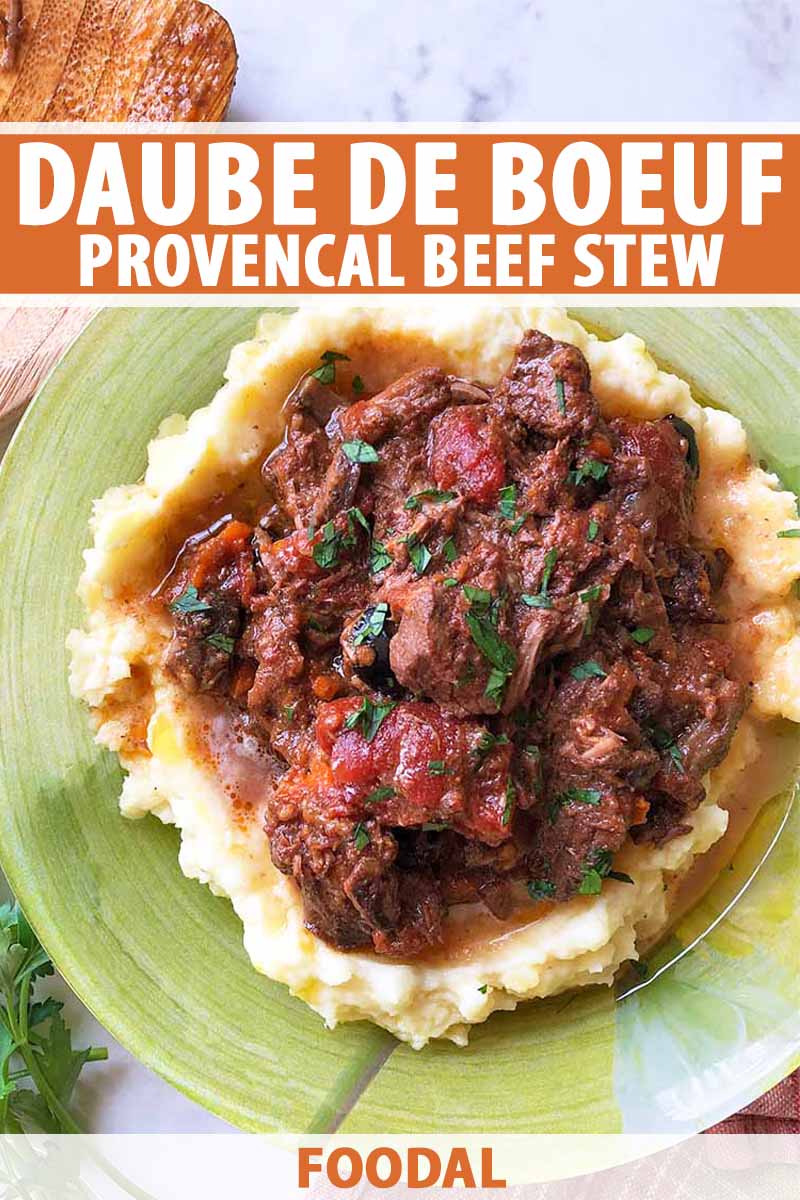
For those who are well-versed in classic French beef stews, I know what you’re thinking. And you’re right. This is not boeuf bourguignon.
As opposed to the more savory flavors of bourguignon (like fatty bacon and beef stock), this country-style version gets its sophisticated, powerful perfume from spicy cloves, sweet orange, and nutty, mellow French olives.
But let me begin by getting one very important proclamation out into the open: Julia Child is my homegirl.
What do I mean by that?
See: tiny imaginary cook who sits on my shoulder and nudges me to add more butter and cream to everything.
If you and I have that in common with me, I’d be willing to bet that you’re just as familiar with beef bourguignon as you are with the movie Julie and Julia.
In this wonderfully food-centric, fact-based story, the lives of Julia Child and Julie Powell (a New York blogger-turned-author who cooks her way through Julia’s cookbook) are paralleled in different time periods.
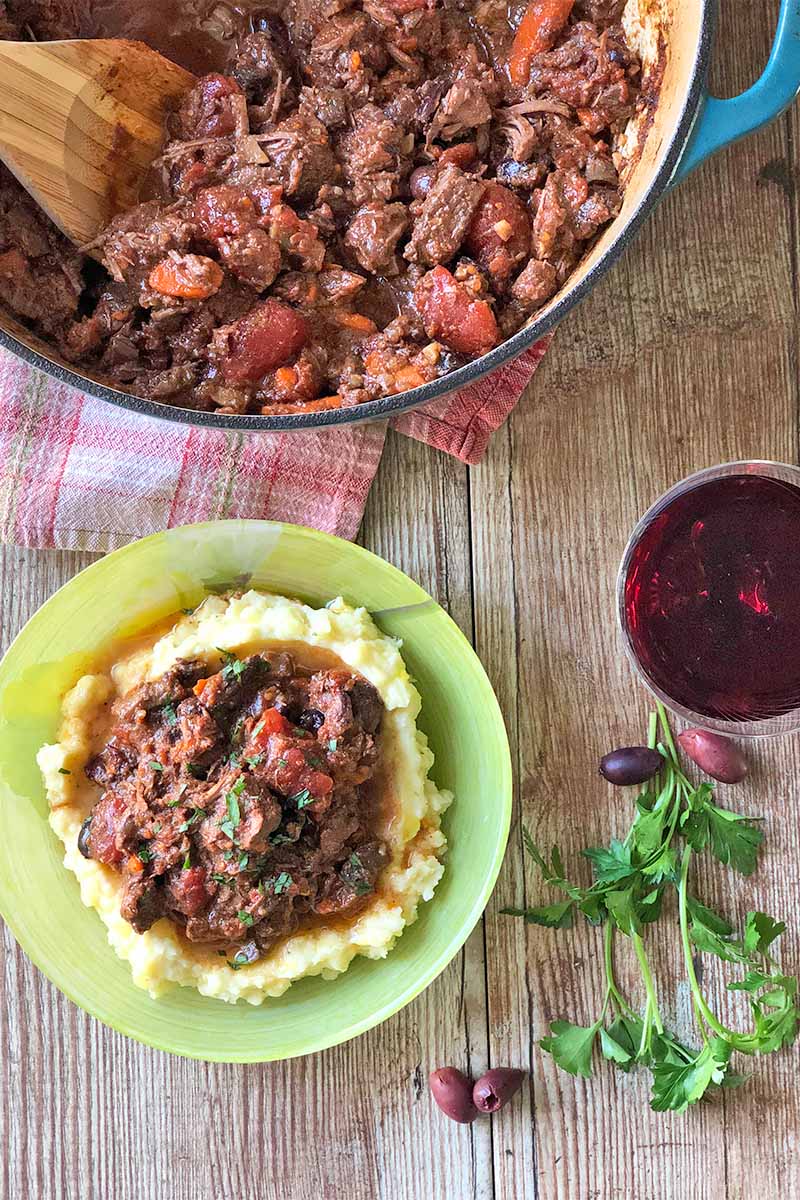
At one point, Julie Powell gets the opportunity to prepare boeuf bourguignon for Judith Jones, the legendary editor who championed Julia Child’s book “Mastering the Art of French Cooking,” and helped to make it a masterpiece.
The audience watches in anticipation as Julie cautiously sears each piece of meat, splatters red wine onto her copy of Julia’s cookbook, and then nervously places the pan into the oven.
She sets a six-hour timer, settles onto her couch with a cocktail, and lo and behold – sleeps through her alarm, missing the moment when the savory stew is supremely tender and ready to serve, and instead discovering something that is disappointingly burnt and too far gone to save.
I’m not sharing this tale to scare you away from making slow-simmered dishes. In fact, what I have in mind is quite the opposite.
I’m simply reminding you that when it comes to a recipe that requires hours of marinating and braising, planning in advance is the best approach you can take. And for a super flavorful daube, aka stew, putting in those hours of passive time is where it’s at.
Catching a buzz and snoozing through your kitchen timer is not encouraged here. Channeling Julia Child and making something French-style that is supremely satisfying very much is.
Now, let’s chat about some of the elements that differentiate this daube de boeuf Provencal from the perhaps more commonly known boeuf bourguignon.
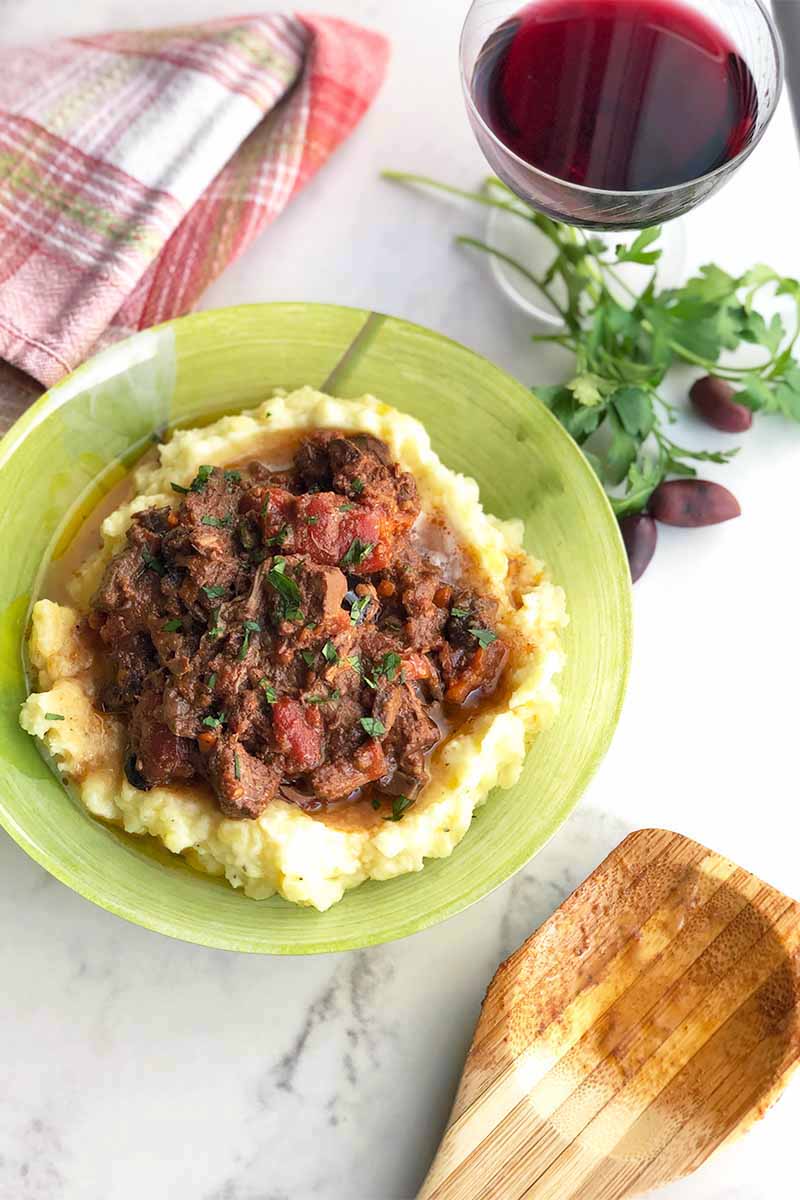
First, we have the marinade. Where the bourguignon style simply begins by patting dry and then searing the beef, the Provencal variety begins six hours ahead, or more, with a tasty soak.
Again, planning is everything. The morsels are first immersed into a flavorful mixture that will double as part of the braising liquid, and this takes time.
Although the end result is hearty and rich, fragrant aromatics lighten up the overall profile of the dish. Juicy tomatoes lend sweetness and acidity, and after bubbling away for six hours at a leisurely pace, the sauce is reduced and beautifully concentrated with warmth.
You can practically smell it already, can’t you?
I’m a sucker for serving buttery mashed potatoes beneath this glorious mountain of meat, but egg noodles or even crusty garlic bread also work like a charm. Take your pick.
Honestly, you put so many hours into creating this meal that sopping up every last drop however you can is far more important than agonizing over which specific starch is your soaking implement of choice.
With a little planning and patience at the forefront, plus a pat on the back from your imaginary Julia Child angel, you’ll be licking the plate in no time.
Bon appetit!
Print
Daube de Boeuf (Provencal Beef Stew)
- Total Time: 12 hours, 40 minutes
- Yield: 4-6 servings 1x
Description
Chilly nights call for hearty stews, and this French-inspired classic made with rich red wine and bright orange zest will warm you right up.
Ingredients
- 1 750-milliliter bottle dry red wine
- 4 tablespoons neutral oil (such as vegetable or grapeseed), divided
- 1/8 teaspoon ground cloves (or 4 whole cloves)
- 1 teaspoon grated orange zest, plus more for garnish
- 1 dried bay leaf
- 2 pounds beef shoulder or chuck roast, cut into 2-inch cubes
- 1 1/2 teaspoons coarse salt, divided, plus more to taste
- 3/4 teaspoon freshly ground black pepper, divided, plus more to taste
- 1 large sweet onion, rough chopped (about 3 cups)
- 2 carrots, rough chopped
- 8 ounces white button or cremini mushrooms, stems on, rough chopped
- 4 large cloves garlic, minced
- 1 tablespoon chopped fresh thyme
- 1 28-ounce can whole peeled tomatoes
- 2 tablespoons pitted and chopped Nicoise olives
- 2 tablespoons chopped fresh parsley
Instructions
- Prepare the marinade by whisking together the wine, 2 tablespoons of the oil, the ground cloves, and the orange zest. Pour the mixture into a large resealable bag, and add the bay leaf and the beef. Marinate the beef in the refrigerator for at least 6 hours, or preferably overnight.
- When you are ready to cook, preheat the oven to 300°F.
- Take the chill off the meat by allowing it to come to room temperature before you’re ready to begin cooking, and then drain it in a colander with a bowl underneath to catch any marinade that drips off. Reserve the remaining marinade.
- Dry the beef using paper towels, and then season the meat with 1 teaspoon salt and 1/2 teaspoon pepper.
- In a large heavy-bottomed oven-safe pot like a Dutch oven or cast iron pan placed over medium-high heat, add the remaining 2 tablespoons oil, and swirl to coat the pan. Working in batches so you don’t steam the meat, sear the beef until it is dark golden brown on all sides. Using a slotted spoon, remove the beef pieces from the pan and set them aside on a plate.
- Lower the heat to medium. Add the onions, carrots, mushrooms, garlic, thyme, and remaining salt and 1/4 pepper. Saute until the onions have softened, about 3 minutes.
- Return the beef pieces and their juices to the pan, and then stir in the leftover marinade and tomatoes. Bring the mixture to a rolling boil, and cook for 3 more minutes.
- Cover the pot, place in the oven, and bake until the meat is fall-apart tender, about 6 hours. Just before serving, stir in the olives, and then season the sauce to taste with additional salt and pepper if necessary. Remove the bay leaf and any whole cloves.
- Garnish with the parsley, and orange zest to taste. Serve over mashed potatoes or another starch like egg noodles.
- Prep Time: 15 minutes
- Cook Time: 6 hours, 25 minutes
- Category: Stew
- Method: Stovetop, Slow Cooked
- Cuisine: French
Keywords: beef, slow cooked, stew, red wine, tomatoes, provencal
Cooking By the Numbers…
Step 1 – Cube and Marinate the Beef
Cut the beef into 2-inch cubes.
Zest the orange, and be sure to zest some extra orange peel to use as garnish when the dish is finished.
Prepare the marinade by whisking together the wine, 2 tablespoons of the oil, the cloves, and 1 teaspoon of the orange zest. Any type of neutral vegetable oil is fine; canola or grapeseed make good options.
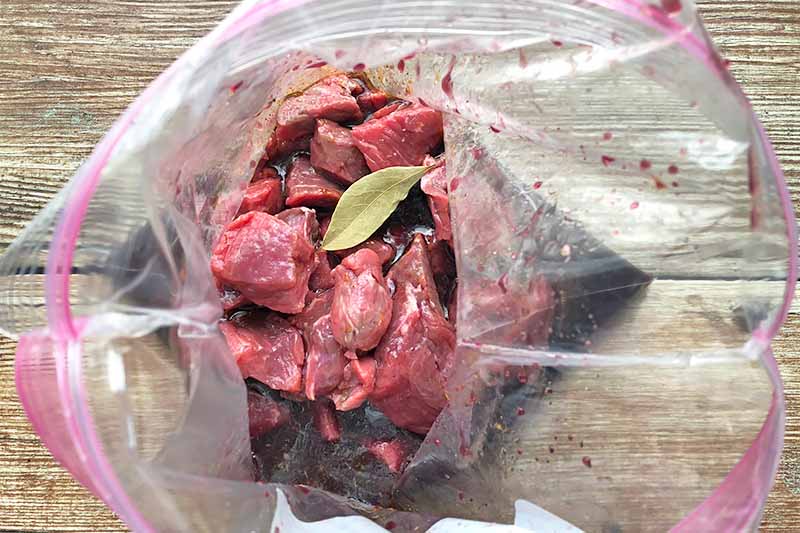
It’s fine to use whole cloves instead of the ground spice, if that’s what you have on hand. Just remember to remove them before serving.
Pour the mixture into a large resealable bag, and add the beef and the bay leaf. Marinate the beef in the refrigerator for at least 6 hours, or at best, overnight.
Step 2 – Dry and Sear the Beef and Chop the Veggies
Allow the meat to come a bit closer to room temperature by letting it sit on the counter for about 30 minutes before you’re ready to start cooking.
Taking the chill off will help to promote more even cooking all the way through, and it will take less time for the meat to lose moisture while it’s cooking, paving the way for more delicious browning.
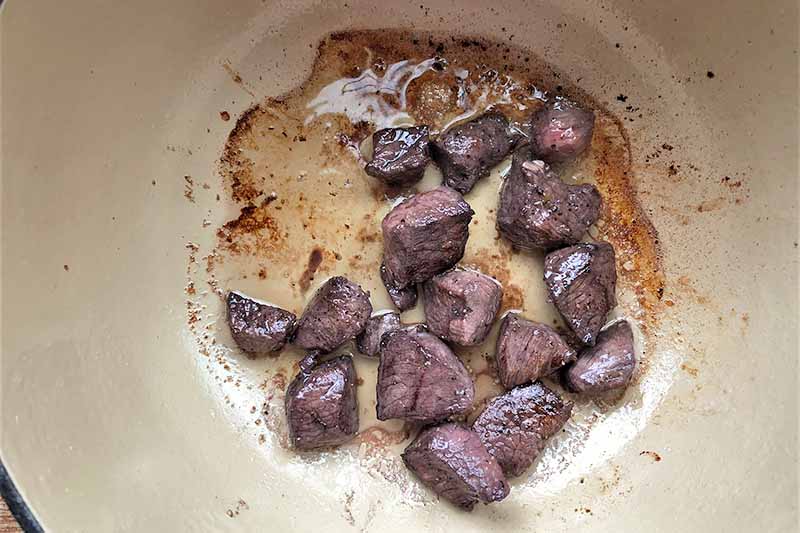
Preheat the oven to 300°F. Cooking the stew at a lower temperature ensures very tender meat.
Peel and chop the onions and carrots. Chop the mushrooms, with the stems on. Remove the stems from the thyme and chop. Mince the garlic.
Place the meat in a colander with a bowl underneath to catch any marinade that drips off. Reserve the remaining marinade.
Blot the beef dry with paper towels, and then season the pieces with 1 teaspoon of salt and 1/2 teaspoon of freshly ground black pepper. The drier the beef, the better the sear will be, and browning the meat before braising it in the oven adds a delicious layer of flavor.
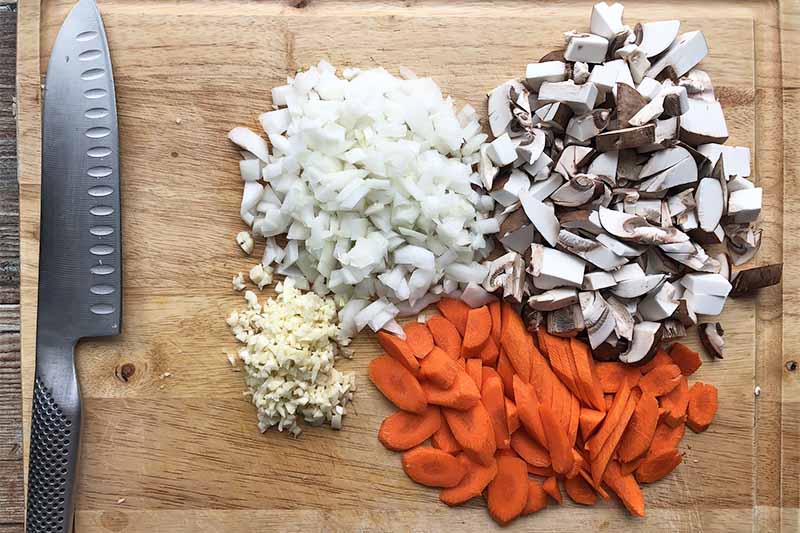
Swirl the remaining 2 tablespoons of oil in a large heavy-bottomed pot like a Dutch oven or cast iron pan until it begins to shimmer, and place it over medium-high heat.
Working in batches so you don’t crowd and steam the meat, sear the beef until it’s dark golden brown on all sides. If the beef renders a lot of fat, you can pour some of the liquid out between batches.
Using a slotted spoon, remove the browned beef pieces from the pan and set them aside on a plate. After all of the meat has been seared on all sides, lower the heat to medium.
Step 3 – Saute the Vegetables, Add the Braising Liquids, and Cook
Add the onions, carrots, mushrooms, garlic, thyme, and remaining 1/2 teaspoon of salt and 1/4 teaspoon of pepper to the pan. Saute until the onions have softened, about 3 minutes.
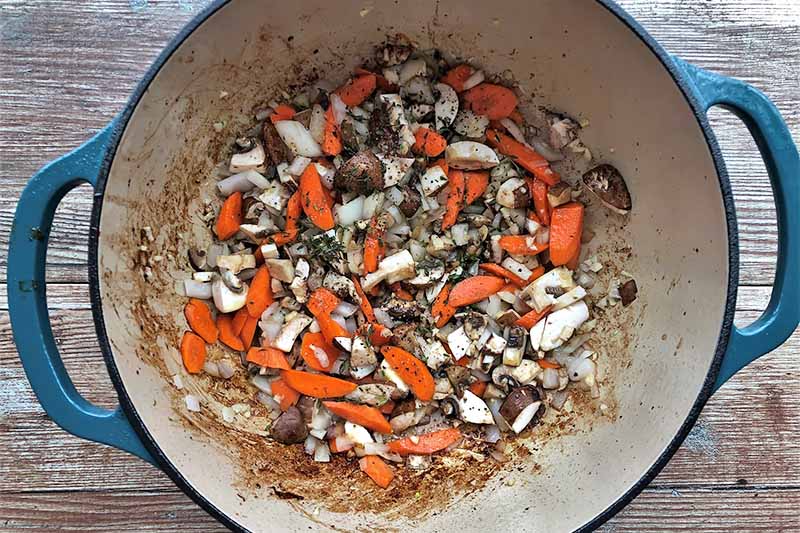
Return the beef pieces and their juices to the pan, and then stir in the leftover marinade and tomatoes.
Bring the mixture to a rolling boil, then continue to cook for 3 minutes. Boiling the marinating liquid kills any of the bacteria that may be present from the raw meat that it touched.
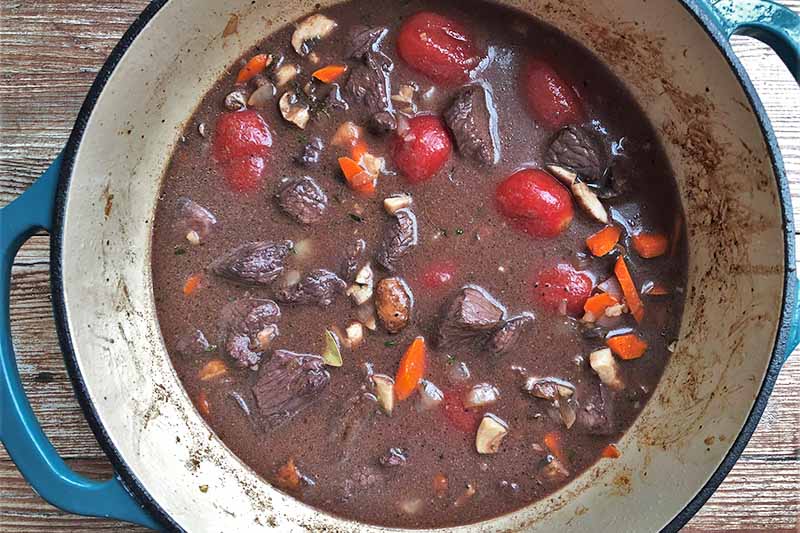
Cover the pot and bake until the meat is tender and falling apart, for about 6 hours.
Is 6 hours a little… long? You can learn how to cook beef stew in the pressure cooker with our tutorial!
Step 4 – Stir in the Olives, Garnish, and Serve
Chop the parsley. Remove the pits if you need to, and chop the olives.
If you aren’t able to find Nicoise olives (if you don’t have some leftover from your Nicoise salad!), another French variety like Picholine will work, or you can also substitute kalamata or black olives.
Just before serving, stir in the olives, and then season the sauce to taste with additional salt and pepper if necessary.
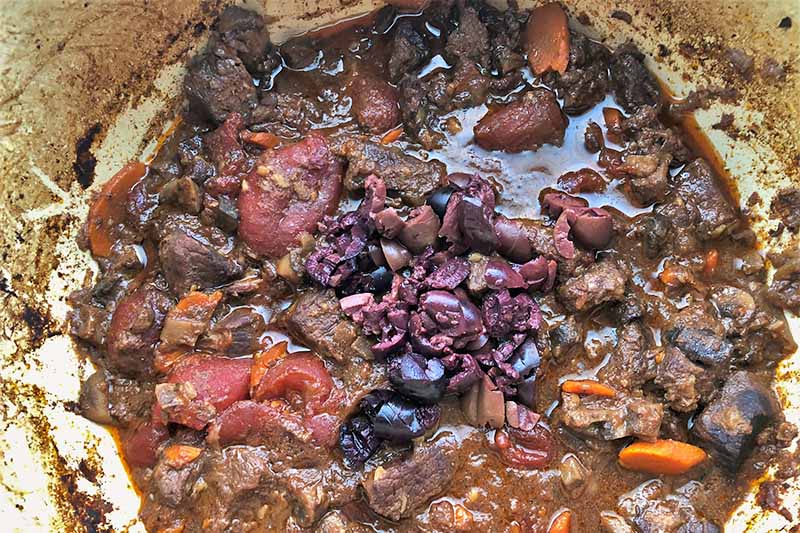
Remove the bay leaf (and the cloves if you used whole ones).
Serve the stew over mashed potatoes or another starch of your choice like egg noodles, and garnish with the parsley and additional orange zest.
A Splash of Red Wine and a Dash of Patience
When it comes to dishes that take half a day to marinate and half a day more to cook, don’t try to tackle everything at the last minute. Patience and planning are two of the most important ingredients in daube de boeuf Provencal.
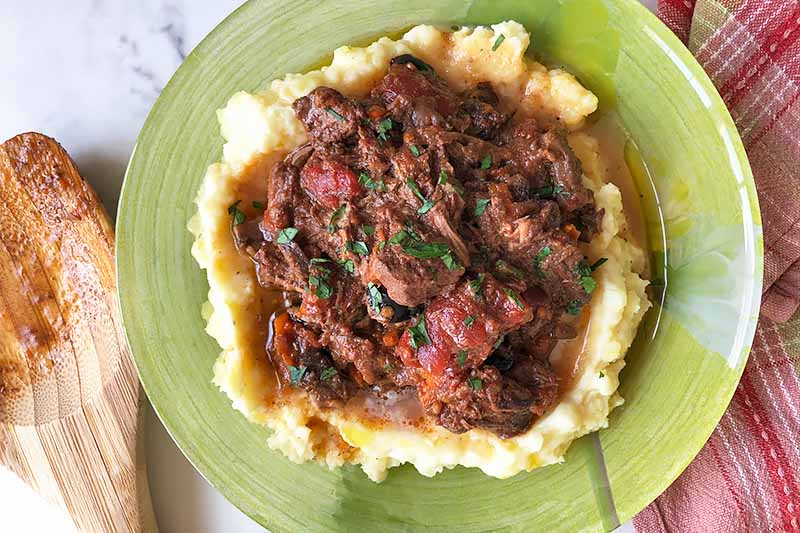
Since the meat can happily soak in its red wine-orange-clove bath for a full day, here’s the plan:
To serve the stew for dinner on Saturday, let the meat marinate on Friday night while you sleep. Once Saturday morning arrives, bring the beef to room temperature, and let the games begin. The enticing smell of simmering stew will fill the house with warmth and happiness all day, and once dinnertime hits, the cooking part is just about complete.
For more cold-weather comfort foods where slow-cooked red meat is the star, check out these rustic recipes next:
- Game Day Chili
- Slow Cooker Beef and Vegetable Stew with Guinness Stout
- Authentic Moroccan Lamb, Veggie, and Lentil Stew
A refreshing salad helps to cut through the richness of this stew. I reach for simple greens when I serve mine, tossed with a lemon vinaigrette.
How will you balance out the hearty flavors of this meal? Share your bright, simple sides in the comments below! And don’t forget to give this recipe a five-star rating if you loved it.
Photos by Fanny Slater, © Ask the Experts, LLC. ALL RIGHTS RESERVED. See our TOS for more details. Originally published on November 1, 2010. Last updated on December 26, 2020.
Nutritional information derived from a database of known generic and branded foods and ingredients and was not compiled by a registered dietitian or submitted for lab testing. It should be viewed as an approximation.
About Fanny Slater
Fanny Slater is a home-taught food enthusiast based in Wilmington, North Carolina who won the “Rachael Ray Show” Great American Cookbook Competition in 2014, and published her cookbook “Orange, Lavender & Figs” in 2016. Fanny is a food and beverage writer, recipe developer, and social media influencer. She was a co-host on the Food Network series “Kitchen Sink,” was featured on Cooking Channel’s longtime popular series “The Best Thing I Ever Ate,” and continues to appear regularly on the “Rachael Ray Show.”

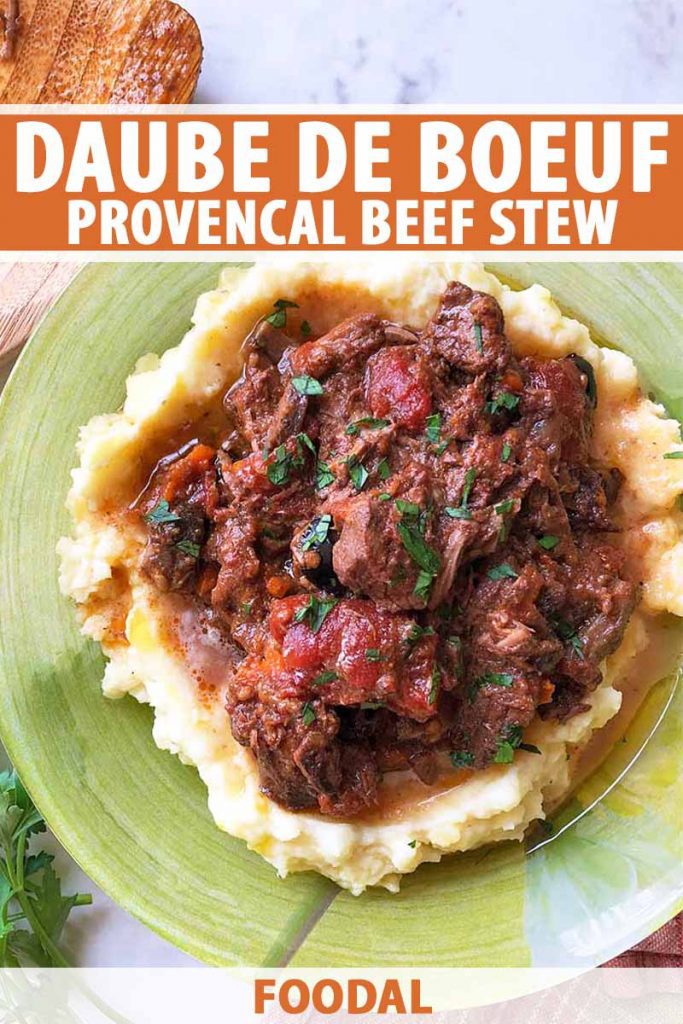
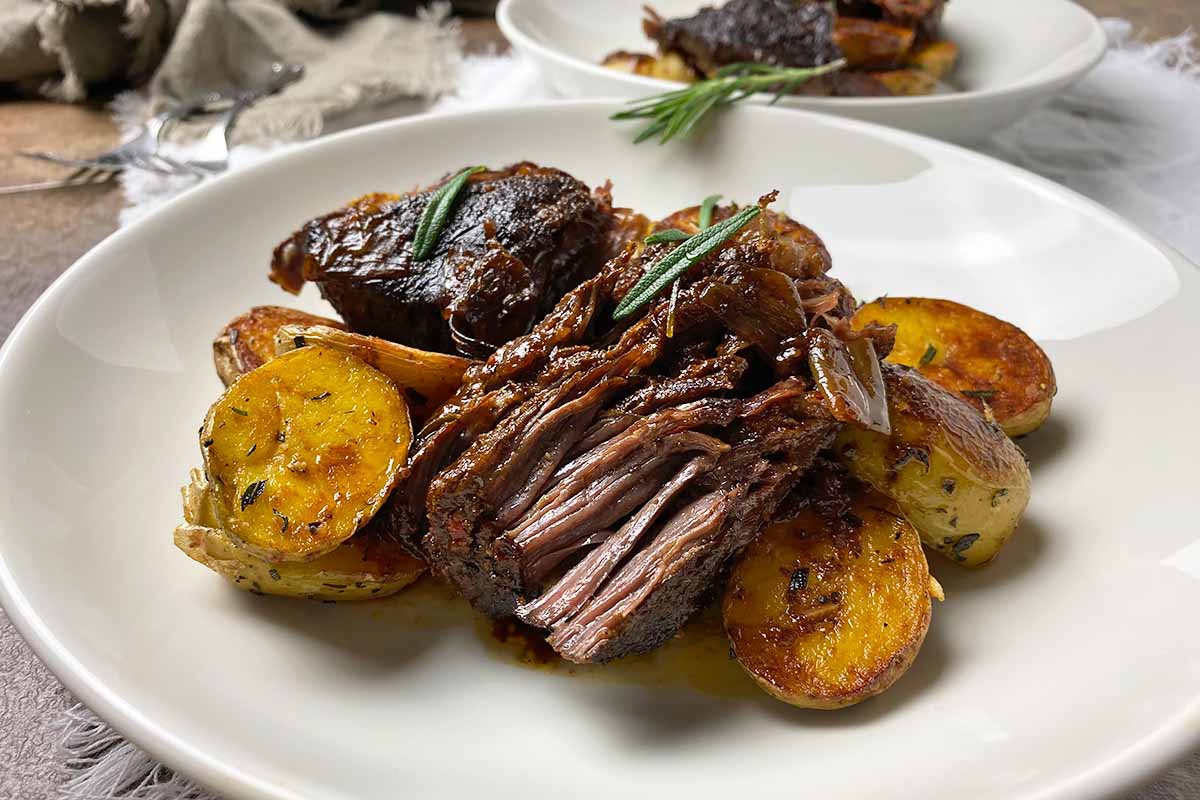
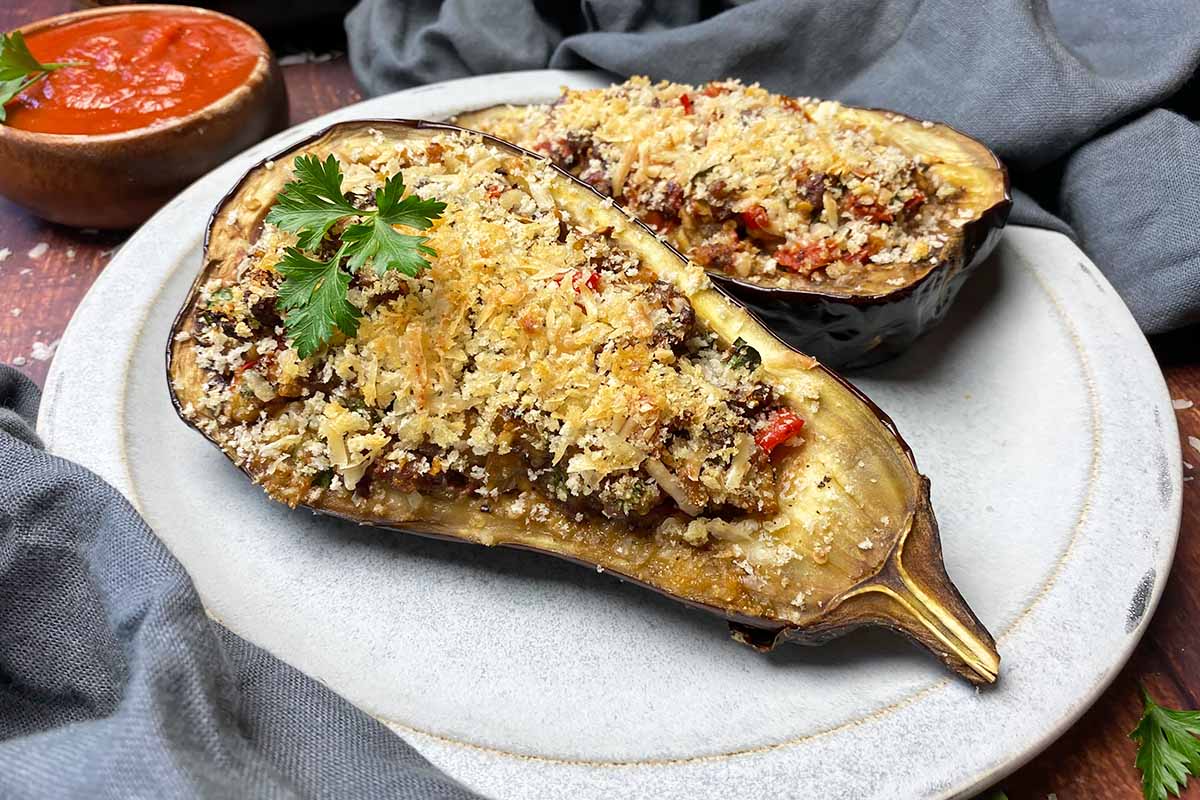
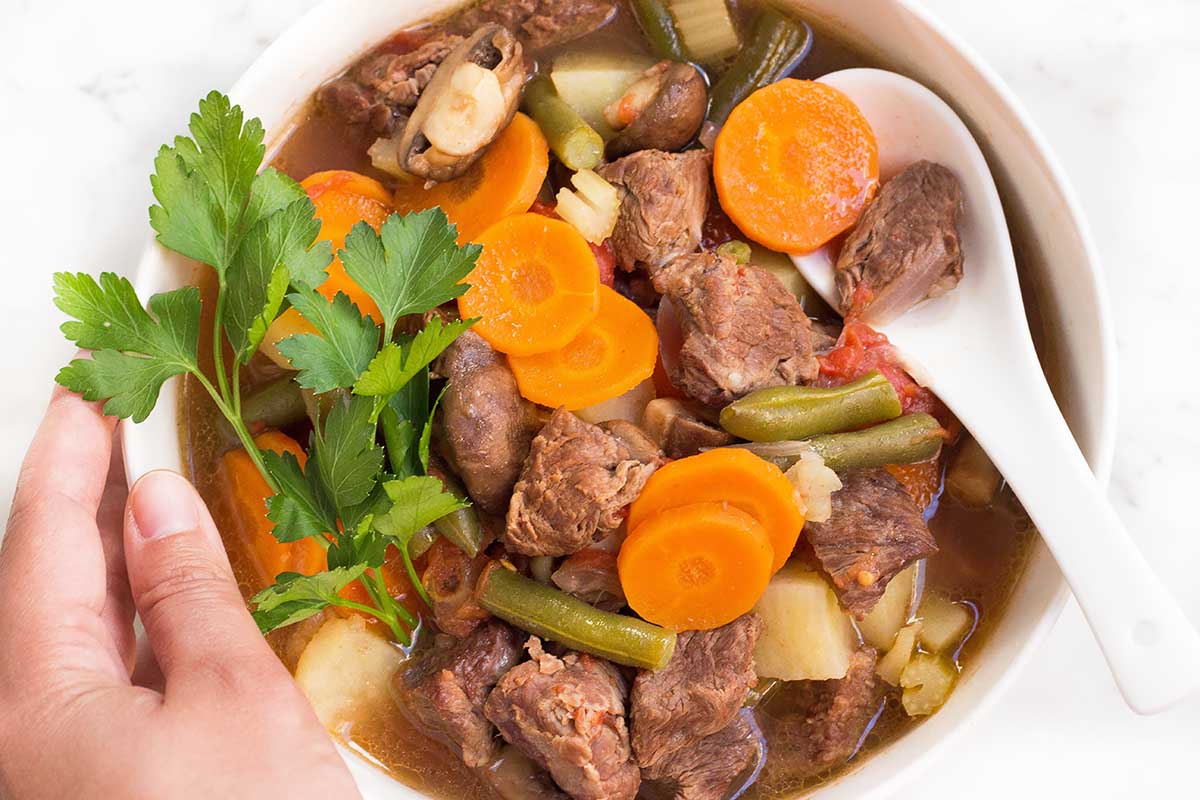
When making bone broth, any left over gets canned and put in the pantry for later use. Like for instance hot meat loaf sandwiches etc. We have limited fridge and freezer space.